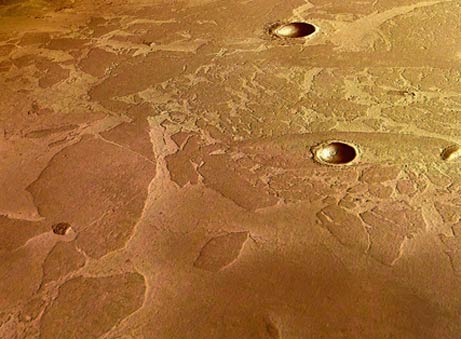NASA has fallen a long way since the heady days of the 1960’s when budgets were fat and it seemed that the space agency could do nothing wrong in the eyes of the American people. Of course, a large part of that was politics. Presidents Kennedy, Johnson, and Nixon all found it politically useful to garner some reflected glory from NASA’s towering achievements by being chummy with astronauts. That and naked cold war power politics which turned the space race into an exercise in chest thumping, nationalistic one upsmanship allowed NASA considerable leeway in its budgetary priorities.
Alas, nothing lasts forever and by 1975, NASA had fallen victim in part to its own success. Promising the shuttle miracle – a craft that could not only take off and land but also allow the agency to turn a profit – NASA ended up delivering what was essentially an Edsel. The high expectations NASA engendered for the shuttle turned out to be wildly unrealistic. Instead of flying 30 to 35 times a year as originally planned, that number has now been reduced to 6 or less. And the corporations that were supposed to line up for space on the shuttle to deploy their satellites have mostly found better, cheaper alternatives. NASA now competes with not only American companies to launch payloads, but also the European Space Agency, the Japanese, and soon the Chinese will throw their space helmets into the ring.
What happened?
A major lack of leadership both in the executive branch and at NASA itself is mostly to blame. The agency was allowed to deteriorate from a program that embodied the highest hopes and biggest dreams of the American people into just another ossified government bureaucracy. The Challenger disaster exposed the agency’s weaknesses as well as a callousness that shocked those of us who had followed the program from its inception. And NASA’s most recent catastrophe – the Columbia disaster – revealed the agency to be a rudderless ship, unable to make the necessary changes to both hardware and procedures to get the Shuttle flying again in a timely manner.
Part of the problem is NASA’s budget and the priorities the agency sets every year. The Shuttle should be seen as a vacuum cleaner, sucking money away from programs that actually advance scientific discovery. Flying below the public’s radar are a host of NASA successes that have transformed everything from physics to engineering. NASA missions in the last decade have opened up brand new scientific vistas using space based gamma ray and x-ray telescopes, rovers on Mars, a probe to Saturn’s moon Titan, and most recently, the extraordinary achievement of the Deep Impact probe. This is what NASA does best – build and launch probes that private industry wouldn’t touch.
But the agency’s manned program is a different story. To put it bluntly, it’s just too damned expensive. Yesterday’s launch cost NASA about $10,000 per pound to put the astronauts in low earth orbit. Even with the next generation of reusable launch vehicles (RLV), the agency is shooting to only lower that figure to $1000 per pound and most engineers think that number unattainable. The problem is that human beings need to be kept alive in space which has turned out to be an extraordinarily expensive undertaking.
Some of the difficulties may be overcome by using different kinds of boosters with different ways to propel the craft into space. Hybrid engines currently under development use different propellants than the standard mixture of liquid oxygen and hydrogen. Rockets using nuclear power have been tested successfully but are unlikely to be built due to environmental concerns. The next generation will use a mixed fuel booster with solid propellant rockets used at liftoff. Still expensive but it might halve the cost of putting man in space.
This begs the entire question of why NASA should be putting men in space in the first place. The “Space Station” is another NASA project that promised much and has been both oversold and is now over budget. The Russian contribution has been consistently late and not up to specs. I have to add that Moscow did us a huge favor by ferrying people back and forth to the station using their good old fashioned Soyuz spacecraft. And we’re using their good old fashioned Progress rockets for resupply missions.
For the foreseeable future, NASA is stuck in low earth orbit. Although Congress has just approved initial funding for a planned moon landing in 2015, and a Mars landing a decade or so beyond that, the proof for Congress will be in NASA’s ability to operate efficiently with the funds that are appropriated. Watching NASA’s performance over the last months, I don’t have much confidence in the agency’s ability to convince Congress that it’s wasteful ways have changed.
Scientist James Van Allen who discovered the band of radiation that encircles earth and protects us from cosmic rays thinks that NASA’s time has passed:
My position is that it is high time for a calm debate on more fundamental questions. Does human spaceflight continue to serve a compelling cultural purpose and/or our national interest? Or does human spaceflight simply have a life of its own, without a realistic objective that is remotely commensurate with its costs? Or, indeed, is human spaceflight now obsolete?
I am among the most durable and passionate participants in the scientific exploration of the solar system, and I am a long-time advocate of the application of space technology to civil and military purposes of direct benefit to life on Earth and to our national security. Also, I am an unqualified admirer of the courageous individuals who undertake perilous missions in space and of the highly competent engineers, scientists, and technicians who make such missions possible.
In a dispassionate comparison of the relative values of human and robotic spaceflight, the only surviving motivation for continuing human spaceflight is the ideology of adventure. But only a tiny number of Earth’s six billion inhabitants are direct participants. For the rest of us, the adventure is vicarious and akin to that of watching a science fiction movie. At the end of the day, I ask myself whether the huge national commitment of technical talent to human spaceflight and the ever-present potential for the loss of precious human life are really justifiable.
Van Allen is correct in his assessment as far as it goes. Perhaps it is time for governments to get out of the business of putting human beings into space. The aforementioned ISP was supposed to be completed by 2000. Instead, it may not be finished until 2010 at a cost of some $80 billion which is overbudget by a factor of 5. Could such an endeavor be done more cheaply?
The answer is absolutely yes. There are about a dozen corporations that are vying to ferry human beings into space. The suborbital flight last year of Spaceship One is just the first step. Plans are afoot by several companies to develop orbiting spacecraft as well as build their own space station. Originally for the super rich who would be willing to pay the hefty $20 million to go into space, as more companies become involved and competition heats up, that price will come down considerably.
And then there’s the space elevator.
A space elevator is a physical connection from the surface of the Earth, or another planetary body such as Mars, to a geostationary Earth orbit (GEO – In the case of Earth) above the Earth at roughly 35,786 km in altitude.
It is hoped that someday a space elevator would be utilized as a transportation and utility system for moving people, payloads, power, and gases between the surface of the Earth and space. It makes the physical connection from Earth to space in the same way a bridge connects two cities across a body of water.
NASA is looking very seriously at such a project as are a half a dozen private companies. An elevator from earth’s surface to a space hotel for tourists may be a lot closer to realization than some think. The technology is there. All that’s needed is the will and the funding.
The fact is that alternatives to NASA’s manned space program will be commonplace in a decade. I wouldn’t be surprised if when this next generation of RLV’s was retired in 2025, NASA will get out of the business of putting people in space entirely. By then, I have no doubt that spaceflight will be much closer to being available to anyone of a little more than modest means.
UPDATE
No sooner had I finished writing this article than NASA discovered a rather large chunck of insulation had fallen off the booster during liftoff of the orbiter. Thankfully, it didn’t smash into the Shuttle and damage any of the tiles that protect the spacecraft on re-entry. But since this was one problem that NASA thought it had solved, the Shuttle fleet will be grounded until they figure out how to fix the problem.
Officials do not believe the foam hit the shuttle, posing a threat to the seven astronauts when they return to Earth on Aug. 7. But they plan a closer inspection of the spacecraft in the next few days to be sure.
“You have to admit when you’re wrong. We were wrong,” Parsons said. “We need to do some work here, and so we’re telling you right now that the … foam should not have come off. It came off. We’ve got to go do something about that.”
The loss of a chunk of debris, a vexing problem NASA thought had been fixed, represents a tremendous setback to a space program that has spent 2 1/2 years and over $1 billion trying to make the 20-year-old shuttles safe to fly.
“We won’t be able to fly again,” until the hazard is removed, Parsons told reporters in a briefing Wednesday evening.
The forces at work during a Shuttle lift off are simply awesome. The vehicle generates 6 million pounds of thrust when both the solid rocket boosters and external fuel tank are ignited. No matter how well the systems are designed, there are going to be unforseen stresses on different areas of the spacecraft. And travelling at several thousand miles per hour through the atmosphere under a “Max-Q” of nearly 7 G’s also makes trying to predict stress points exactly an almost insurmountable problem.
My guess would be that NASA will spend 6 months in meetings and in typical fashion will declare that the insulation falling off will be “an acceptable flight risk.” Like the “O” Rings that caused the Challenger disaster and a half dozen other problems NASA has examined in the past, when no solution presents itself they simply lower the safety bar. They really have no other choice except to ground the Shuttle altogether. And given the investment the government has in the International Space Station and the Shuttle’s vital role in ferrying supplies and personnel to that boondoggle in the sky, that won’t happen.
Kevin at Wizbang offers this thought:
Much as you wouldn’t keep pouring cash into a clunker automobile, it’s time to admit that the shuttle fleet is end-of-life and start work on a new space vehicle design.
They already have started work. The problem is it won’t be ready for at least 5 years. And unless we want to swallow our pride and admit our incompetence entirely be continuing to depend on Russians to get us poor Americans back and forth from the Space Station, we have no alternative but to continue holding our breath every time the Shuttle launches or re-enters.
UPDATE II
Rand Simberg offers some interesting thoughts:
I think that it’s most likely that they will decide to come home with it as is. And if they do, I also think that they will undergo a great deal of ignorant criticism for this decision, because they’ve “lost their safety culture,” just one flight after they killed all those astronauts, and now they’re recklessly gambling their lives again (disregarding the fact that throwing away a two-billion dollar vehicle, and a third of the remaining fleet, is not a decision to be taken lightly either).
It’s not a question of NASA “losing” their safety culture as much as it is raising the bar of “acceptable risk” which I suspect Rand would agree with. Whether that’s a good thing because of past over cautiousness or whether it’s not a good thing is a moot point. Prior to launch, NASA said that there was a 1 in 100 chance the Shuttle would be destroyed. I don’t think there are too many people who would accept those odds and go into space.




























